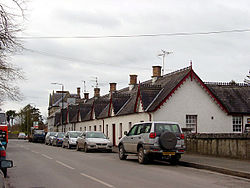Benburb
| Benburb | |
| Tyrone | |
|---|---|
 Benburb | |
| Location | |
| Grid reference: | H815522 |
| Location: | 54°24’43"N, 6°44’45"W |
| Data | |
| Post town: | Dungannon |
| Postcode: | BT71 |
| Dialling code: | 028 |
| Local Government | |
| Council: | Dungannon & South Tyrone |
| Parliamentary constituency: |
Fermanagh & South Tyrone |
Benburb is a village and townland in Tyrone. It stands seven and a half miles from Armagh and eight miles from Dungannon. The village is on the north bank of the River Blackwater, which forms the county border with Armagh, and by the village passes the Ulster Canal.
The name of the village is from the Gaelic Beann Borb, meaning 'proud/prominent cliff'.[1] It is in the Barony of Dungannon Middle.
History
The village is best known, in historical terms, for the Battle of Benburb that took place there in 1646. This was fought between the armies of Confederate Ireland led by Owen Roe O'Neill and the Scottish Covenanters led by Munro. The battle resulted in a crushing victory for O'Neill's men at the townland of Drumflugh around a mile outside the village. It was commemorated in the ballad "The Battle of Benburb".
Since the Battle of Benburb was a rare 17th-century Irish military victory, in 1890 new Irish nationalist dominated Corporation in Dublin city renamed Barrack Street in Dublin's north inner city after the battle. Benburb Street runs between Queen Street and Blackhall Place. There is also a Benburb Street in south Belfast just off the Donegall Road.
In later years Benburb became known for its linen production, as did many areas in Ulster and later still for agriculture, most notably apple farming, and mushroom production.
Benburb was the home of the 17th century poet Maurice O'Dugan (fl.1660), who was reputed to have written the poems Gluas do chabhlach, Bhi Eoghan air buile, Faraoir chaill Eire a céile fircheart and the famous air The Coolin.[2]
Places of interest
The village is also home to the impressive Benburb Castle built in 1611 by Sir Richard Wingfield on the ruins of a military fortification constructed by Prince Shane O'Neill, circa 1558, at the base of a limestone cliff overlooking the River Blackwater, the border between County Tyrone and County Armagh. The castle is in excellent condition having been recently restored and stands in the grounds of the imposing Servite Priory, a religious order based in the village.
Benburb Priory
Wingfield was made Viscount Powerscourt in 1618 and the estate remained in the Wingfield family until sold in 1877 to Belfast distiller James Bruce, who died in 1917. It then went to his brother who sold it. The manor house passed through a number of owners before being requisitioned by the War Office as military hospital during Second World War. From 1943 – 1944 members of the Army Medical Corp were stationed there, and from October 1943 to April 1944 it was the home to personnel of the American 7th Field Hospital. The hospital had 135 beds.[3]
The Servite Order acquired the property in 1947, initially for a seminary. In more recent years the Priory has been a cross-community centre supporting over 30 groups spanning culture and heritage, older people, St Peregrine cancer support, education and rehabilitation.
The Priory is also home to Benburb Priory Library and Museum which holds extensive collections of Servite and Marian books and artefacts, the Servite archives for Britain and Ireland, the Priory (formerly Wingfield/Powerscourt) estate and local history. The Library and Museum was established in 2016 (Professor Gerry McKenna MRIA; founding chair) and includes the extensive and valuable private collection of Hugo Ricciardi O'Neill, Chief of the Clans of O'Neill, who resides in Setubal, Portugal.
Outside links
| ("Wikimedia Commons" has material about Benburb) |
References
- ↑ Benburb - Placenames NI
- ↑ Dictionary of National Biography, v.41 (1895), p.458
- ↑ "About us", Benburb Priory
